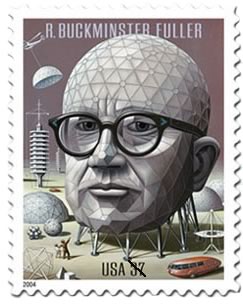

07/2004
Buckminster
Fuller: Yet Another Stamp on the Planet
USPS honors architect and inventor
Fifty years after R. Buckminster Fuller, FAIA patented his Geodesic dome, the U.S. Postal Service has issued a commemorative stamp honoring the brilliant American inventor, philosopher, architect, and engineer. Released on July 12, the stamp features the Boris Artzybasheff painting of “Bucky” with his head in the pattern of a Geodesic dome that originally appeared on the cover of Time magazine on January 10, 1964. Also depicted in the painting are a number of his other inventions, most notably the Dymaxion Car and the 4D House.
 On
July 12, 1895, Fuller was born into a Milton, Mass., family noted for
its individualists and dedication to public service. During family trips
to Bear Island, Maine, Fuller learned the principles of boat construction
and maintenance and developed an understanding and appreciation of nature.
During service in the U.S. Navy, Fuller invented a winch that could pull
airplanes out of the ocean quickly enough to save the crew’s lives.
As a result of his engineering feat, Fuller was admitted to the U.S. Naval
Academy, where he further developed his capabilities. Fuller earned his
first of 25 patents with his father-in-law, James Monroe Hewlett. Together
they developed a new way of manufacturing reinforced concrete buildings.
On
July 12, 1895, Fuller was born into a Milton, Mass., family noted for
its individualists and dedication to public service. During family trips
to Bear Island, Maine, Fuller learned the principles of boat construction
and maintenance and developed an understanding and appreciation of nature.
During service in the U.S. Navy, Fuller invented a winch that could pull
airplanes out of the ocean quickly enough to save the crew’s lives.
As a result of his engineering feat, Fuller was admitted to the U.S. Naval
Academy, where he further developed his capabilities. Fuller earned his
first of 25 patents with his father-in-law, James Monroe Hewlett. Together
they developed a new way of manufacturing reinforced concrete buildings.
Fuller’s lifelong goal was the development of a “Comprehensive Anticipatory Design Science”—an attempt to anticipate and solve humanity’s problems through technology and using fewer resources. Among his designs were the Dymaxion House, an inexpensive, mass-produced home that could be airlifted to its location; the Dymaxion Car, a streamlined, three-wheeled vehicle that could make extraordinarily sharp turns; and a compact, easily installed Dymaxion Bathroom. Coined by store advertisers and trademarked in Fuller’s name, the word “dymaxion” was employed in a number of his inventions and was a fusion of the words “dynamic,” “maximum,” and “ion.” In 1946, Fuller patented the Dymaxion Map—a flat map that depicted the entire planet without visible distortion of the relative shapes and sizes of the continents.
After 1947, the Geodesic dome dominated Fuller’s life and career. Lightweight, cost-effective, and easy to assemble, Geodesic domes enclose more space without intrusive supporting columns than any other structure. In addition, they efficiently distribute stress and can withstand harsh external conditions. Based on “synergetic geometry,” the Geodesic dome was the result of Fuller’s revolutionary discoveries about balancing compression and tension forces in building.
After being spurned early in his career by the architecture and design professions, Fuller was later recognized with many major architectural, scientific, industrial, and design awards, including the AIA Gold Medal in 1970. In 1983, he received the Presidential Medal of Freedom, the United States’ highest civilian honor. Fuller died on July 1, 1983.
The ceremony celebrating the release of the Buckminster Fuller stamp was held at Stanford University, where his papers are archived. In attendance were Fuller’s daughter, Allegra Fuller Snyder, professor emerita, dance and dance ethnology, UCLA; Buzz Aldrin, astronaut, Gemini 12 and Apollo 11; Joshua Arnow, president, board of directors, the Buckminster Fuller Institute; Michael A. Keller, university librarian, Stanford University; and Anita Bizzotto, senior vice president and chief marketing officer, U.S. Postal Service.
Copyright 2004 The American Institute of Architects.
All rights reserved. Home Page ![]()
![]()
 |
||
|
|
||